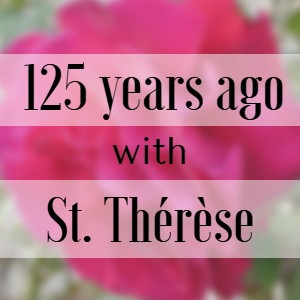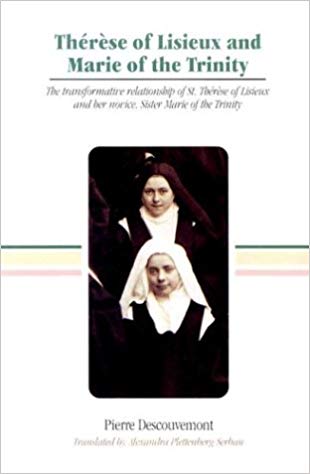Saint Therese of the Child Jesus
of the Holy Face
Entries in Marie-Louise Castel (1)
125 years ago with St. Therese: Sister Marie of the Trinity enters the Carmel of Lisieux on June 16, 1894
 With thanks to Deb Thurston for this logoOn June 16, 1894, Marie-Louise Castel, later named Sister Marie of the Trinity, entered the Carmel of Lisieux as a postulant. This day turned out to be an important event in St. Therese's life. At last, she was no longer the youngest in the community. She was to develop an intimate friendship with Marie of the Trinity, who would be one of the most important witnesses at the process for the beatification and canonization of Therese.
With thanks to Deb Thurston for this logoOn June 16, 1894, Marie-Louise Castel, later named Sister Marie of the Trinity, entered the Carmel of Lisieux as a postulant. This day turned out to be an important event in St. Therese's life. At last, she was no longer the youngest in the community. She was to develop an intimate friendship with Marie of the Trinity, who would be one of the most important witnesses at the process for the beatification and canonization of Therese.
The novitiate of the Lisieux Carmel
At that time, "first vows" (temporary vows) were not made. A young woman's postulancy usually lasted six months, followed by her reception of the habit. At the end of a year as a novice, the candidate was usually permitted to make her perpetual vows. After making her vows, each woman usually spent another three years living on the novitiate corridor under the authority of the novice mistress, an extended period of initial formation. Then she left the novitiate and moved into the community. Thus, St. Therese, who professed her vows on September 8, 1890, would normally have left the novitiate on September 8, 1893. On that date she asked to remain in the novitiate forever. Her sister Pauline, Mother Agnes of Jesus, then prioress, granted the request. Mother Marie de Gonzague was then novice-mistress, and her touchy character would not have allowed Mother Agnes to appoint Therese officially as assistant novice-mistress. By leaving Therese in the novitiate and calling her "senior novice," Mother Agnes hoped that she could discreetly give the other novices the benefit of a good example and some quiet advice.
The youth of Marie-Louise Castel
Marie-Louise was born on August 12, 1874, at St.-Pierre-sur-Dives in Normandy, the 13th of 19 children of a devoutly Catholic family. Her father, a teacher, refused to accept the 1882 decree of the state declaring the schools secular. Continuing the practice of morning prayer with his students, he was forced to resign, and the family moved to Paris. Like little Therese Martin, Marie-Louise experienced the call to religious life while she was still very young, and, at age 12, she understood that he was called to Carmel. Like Celine, she took a private vow of chastity while still a young laywoman.
Her entrance to two different Carmels
She was received as a postulant by the Carmel of the Avenue de Messine in Paris on April 30, 1891, still more than three months short of her seventeenth birthday. Two years later, her health suffering, she was forced to leave. Her father took her to Trouville to regain her health, and she sought consolation at the Lisieux Carmel in an interview with Mother Agnes of Jesus and Mother Marie de Gonzague. As she recovered, she asked to rejoin the Carmel in Paris, only to find that the priest in charge refused to permit the nuns to receive her until she was 21. The prioress in Paris suggested that she might try the Lisieux Carmel; her native air in Normandy might be better for her health. There she encountered the same obstacle Therese had found: Canon Delatroette, the priest-supervisor of the Carmel, found her too young. Noticing that June 16 was the feast of Our Lady of Perpetual Help, to whom she and her family had a particular devotion, she begged Our Lady to obtain her entrance on that feast, and her prayer was answered. See in this video the enclosure door through which she entered on that very feast, as Therese had entered on April 9, 1888.
Entrée du monastère from Carmel de Lisieux on Vimeo.
In the novitiate of the Lisieux Carmel with Therese
There was a great social divide between Paris and the provinces at that time. Even though Marie-Louise had been born in Normandy, many of the Lisieux nuns considered her a "Parisienne." That, and the fact that she had already spent time in another Carmel, worked against her in their opinion. Mother Agnes named Therese as the new postulant's "angel" (the nun charged with instructing her in the many customs of Carmel). Marie-Louise was the first choir postulant entrusted to Therese. The close spiritual friendship that developed between these two young women is recounted in Pierre Descouvemont's book "Therese of Lisieux and Marie of the Trinity: The Transformative Relationship between St. Therese of Lisieux and Her Novice Sister Marie of the Trinity." I recommend this book especially to those who are looking for new incidents about St. Therese, new reported sayings, and the perspective of someone who lived close to her in Carmel, but was not a blood relative. Sister Marie wrote down and testified about many incidents and sayings of Therese not found elsewhere (Purchases through the links on this page support this Web site).
Like Therese, Marie of the Trinity had to endure a longer than usual wait for her profession, which would usually have taken place about December 1895. Therese suggested that Marie need not wait for her profession to offer herself to Merciful Love, and Marie made that offering, with Therese at her side, on December 1, 1895. When, on April 30, 1896, Marie of the Trinity made her profession, Therese was triumphant and grateful; she told Marie it was one of the happiest days of her own life.
The Castel family and St. Therese
Many links developed between the Castel family and St. Therese. Marie of the Trinity had two brothers and two sisters who entered religious life; her priest-brother served as a chaplain at Lisieux, and her sister entered the Visitation at Caen where Therese's sister Leonie lived. Two other sisters for many years were in charge of Les Buissonnets, Therese's childhood home, and welcomed pilgrims there.
More stories about Marie of the Trinity and St. Therese of Lisieux
To read more about the life of Marie of the Trinity, especially her contributions to the Process of Therese and to making her known and loved and the long trial of the disease of lupus she bore so patiently, visit also the following online sources:
- "Sister Marie of the Trinity," the June 2007 issue of the "spiritual newsletter" of the Abbey of Saint-Joseph de Clairval.
- Fr. Descouvemont's brief online biography of Marie of the Trinity on the Web site of the Archives of the Carmel of Lisieux.
- The obituary circular of Sister Marie of the Trinity, which goes into considerable detail about her life, on the Web site of the Archives of the Carmel of Lisieux.
- Marie of the Trinity's testimony at the diocesan inquiry into Therese's holiness, March 13-15, 1911, on the Web site of the Archives of the Carmel of Lisieux.
